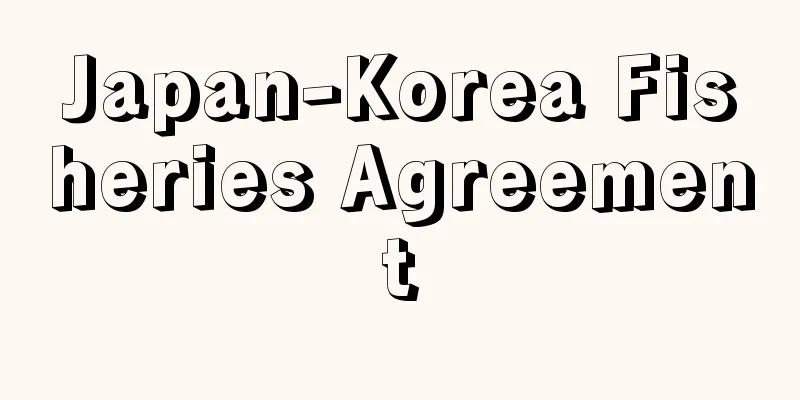Japan-Korea Fisheries Agreement

|
The Japan-Korea Fisheries Agreement, officially called the "Agreement on Fisheries between Japan and the Republic of Korea," was signed on June 22, 1965, and came into force on December 18 of the same year. It was established after 14 years of Japan-Korea negotiations, along with the Treaty on Basic Relations and other related agreements, when diplomatic relations between Japan and Korea were normalized. It mutually recognized that Japan and Korea would establish fishing zones within 12 nautical miles (about 22 kilometers) of the coast, established a joint control zone in the surrounding waters beyond the 12 nautical miles, stipulated the size of fishing boats, mesh size, light power of fishing lights, maximum number of fishing trips, etc. in the joint control zone in the appendix to the agreement, and further set the annual catch volume (equal for Japan and Korea) in the minutes of the agreement. A joint fisheries committee was also established. The agreement stipulated that only the flag state would be allowed to police and have jurisdiction outside the fishing zone (flag state principle), and these regulations essentially abolished the previous Syngman Rhee Line. Then, in 1996, Japan and South Korea each established their own exclusive economic zones, and while negotiations to conclude a new fisheries agreement were proving difficult, Japan notified South Korea of the termination of the 1965 Japan-South Korea Fisheries Agreement on January 23, 1998 (it expired one year after the notice of termination). A new Japan-South Korea Fisheries Agreement (officially the "Agreement between Japan and the Republic of Korea on Fisheries") was then signed on November 28, 1998 (it came into effect on January 22, 1999). This agreement applies to the exclusive economic zones of both Japan and South Korea, and stipulates matters such as the authorization of fishing vessels from the other country in their respective exclusive economic zones, quotas and other operating conditions, and also establishes provisional zones (joint management zones) in the Sea of Japan (around Takeshima) and in parts of the East China Sea (flagging state principle applies within the provisional zones). [Mizukami Chiyuki] [References] | | | |Source: Shogakukan Encyclopedia Nipponica About Encyclopedia Nipponica Information | Legend |
|
正式には「日本国と大韓民国との間の漁業に関する協定」とよばれた日韓漁業協定は、1965年(昭和40)6月22日に署名され、同年12月18日に発効した。日韓国交正常化に際し、基本関係条約および他の関連協定とともに約14年にわたる日韓交渉のすえ成立したもので、日韓が沿岸12海里(約22キロメートル)の水域に漁業水域を設定することを相互に承認し、12海里の外の周辺水域に共同規制水域を設け、協定付属書によって共同規制水域での漁船規模、網目、集魚灯の光力、最高出漁数などを定め、さらに合意議事録で年間漁獲量(日韓で平等)を設定している。また、漁業共同委員会が設置された。協定では漁業水域外の取締りおよび裁判管轄権は旗国のみに認められる(旗国主義)とし、これらの規制内容により、それまでの李承晩(りしょうばん)ラインは実質的に廃止された。そして1996年(平成8)に日韓がそれぞれ排他的経済水域を設定し、それに伴う新しい漁業協定締結のための交渉が難航するなかで、日本は98年1月23日に、この1965年の日韓漁業協定の終了を韓国側に通告した(終了通告の1年後に失効)。その後、98年11月28日に新日韓漁業協定(正式には「漁業に関する日本国と大韓民国との間の協定」)が署名された(99年1月22日発効)。この協定は、日韓それぞれの排他的経済水域に適用することとされ、自国排他的経済水域における相手国漁船の漁獲の許可、割当量その他の操業の条件の決定等について規定し、また、日本海(竹島周辺)と東シナ海の一部に暫定水域(共同管理水域)を設けている(暫定水域内は旗国主義)。 [水上千之] [参照項目] | | | |出典 小学館 日本大百科全書(ニッポニカ)日本大百科全書(ニッポニカ)について 情報 | 凡例 |
<<: Japan-Korea Continental Shelf Agreement
Recommend
Cone penetration test
...A general term for a group of ground investiga...
Uniform pitch blade
…The blade angle is large at the base, and the ci...
Kanazawa Road
...To the east of Yoritomo's tomb is the anci...
Six schools of philosophy
A general term for the six major philosophical sy...
Chief vassal - Chief retainer
After the collapse of the party cabinet due to th...
Salzburg - Salzburg (English spelling)
The capital of the state of Salzburg in central A...
"The Jinbunhen" - Kinbunhen
…Since then, the chronology of bronze inscription...
Gay-Lussac's law
There are two laws, the first law and the second l...
Mazu
A representative Chinese deity of navigation. Ori...
Recruitment phenomenon
Also known as the recruitment phenomenon, this phe...
Hosoe [town] - Hosoe
A former town in Inasa County in the southwest of ...
Kontonken Kunimaru - Kontonken Kunimaru
1734-1790 A kyoka poet from the mid-Edo period. B...
Sentimentalism - Sentimentalism
Generally translated as "sentimentalism,&quo...
Pyralidae
…A general term for insects of the family Pyralid...
Things - things
[1][一] Refers to objects with some form in general...









